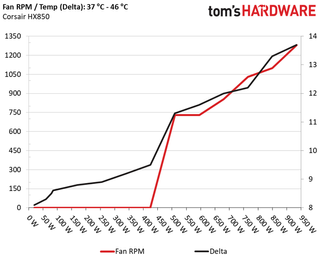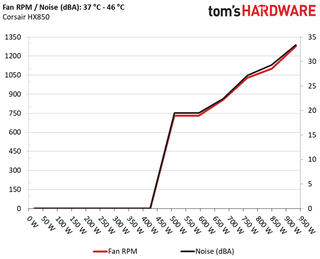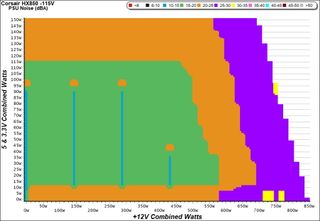Corsair HX850 PSU Review
Why you can trust Tom's Hardware
Efficiency, Temperature & Noise
Efficiency
Our efficiency testing procedure is detailed here.
Using results from the previous page, we plotted a chart showing the HX850's efficiency at low loads, and loads from 10 to 110 percent of its maximum-rated capacity.




Efficiency under normal loads is high. However, under light loads, the HX850 loses to other Platinum-rated PSUs by a large margin.
Efficiency At Low Loads
In the following tests, we measure the HX850's efficiency at loads significantly lower than 10 percent of its maximum capacity (the lowest load the 80 PLUS standard measures). The loads we dialed were 20, 40, 60, and 80W. This is important for representing when a PC is idle, with power-saving features turned on.
| Test # | 12V | 5V | 3.3V | 5VSB | DC/AC (Watts) | Efficiency | Fan Speed | PSU Noise | PF/AC Volts |
|---|---|---|---|---|---|---|---|---|---|
| 1 | 1.212A | 0.491A | 0.479A | 0.197A | 19.691 | 68.364% | 0 RPM | <6.0 dB(A) | 0.842 |
| 12.074V | 5.039V | 3.321V | 5.035V | 28.803 | 115.08V | ||||
| 2 | 2.449A | 0.990A | 0.992A | 0.396A | 39.834 | 80.957% | 0 RPM | <6.0 dB(A) | 0.930 |
| 12.070V | 5.038V | 3.321V | 5.030V | 49.204 | 115.09V | ||||
| 3 | 3.686A | 1.478A | 1.504A | 5.028A | 59.912 | 84.251% | 0 RPM | <6.0 dB(A) | 0.955 |
| 12.066V | 5.038V | 3.321V | 5.028V | 71.111 | 115.08V | ||||
| 4 | 4.911A | 1.984A | 1.985A | 0.796A | 79.814 | 86.747% | 0 RPM | <6.0 dB(A) | 0.971 |
| 12.061V | 5.036V | 3.321V | 5.024V | 92.008 | 115.08V |
We would like to see >70% efficiency with 20W load. During the other three tests, however, the PSU exceeds 80%.
5VSB Efficiency
The ATX specification, along with CEC, ErP Lot 3 2014 and ErP Lot 6 2010/2013, states that 5VSB standby supply efficiency should be as high as possible, recommending 75 percent or higher with 550mA, 1A, and 1.5A of load. The PSU should also achieve higher than 75% efficiency at 5VSB under full load, or with 3A if its max current output on this rail is higher than 3A.
We take six measurements: one each at 100, 250, 550, 1000, and 1500mA, and one with the full load the 5VSB rail can handle.
| Test # | 5VSB | DC/AC (Watts) | Efficiency | PF/AC Volts |
|---|---|---|---|---|
| 1 | 0.102A | 0.515 | 76.637% | 0.066 |
| 5.071V | 0.672 | 115.11V | ||
| 2 | 0.252A | 1.276 | 79.950% | 0.148 |
| 5.067V | 1.596 | 115.10V | ||
| 3 | 0.543A | 2.746 | 80.884% | 0.270 |
| 5.061V | 3.395 | 115.09V | ||
| 4 | 1.002A | 5.064 | 80.714% | 0.388 |
| 5.052V | 6.274 | 115.09V | ||
| 5 | 1.502A | 7.571 | 80.500% | 0.453 |
| 5.041V | 9.405 | 115.09V | ||
| 6 | 3.002A | 15.036 | 79.283% | 0.523 |
| 5.009V | 18.965 | 115.11V |


Corsair's HX850 boasts a highly efficient 5VSB circuit. The OEM, CWT, uses a more advanced 5VSB design than competitors like Super Flower.
Power Consumption In Idle And Standby
In the table below, you'll find the power consumption and voltage values of all rails (except -12V) when the PSU is idle (powered on, but without any load on its rails), and the power consumption when the PSU is in standby mode (without any load, at 5VSB).
| Mode | 12V | 5V | 3.3V | 5VSB | Watts | PF/AC Volts |
|---|---|---|---|---|---|---|
| Idle | 12.079V | 5.040V | 3.321V | 5.038V | 8.479 | 0.462 |
| 115.1V | ||||||
| Standby | 0.047 | 0.005 | ||||
| 115.1V |


We measure very low vampire power under both voltage inputs (115V/230V).
Fan RPM, Delta Temperature, And Output Noise
Our mixed noise testing is described in detail here.
The first chart below illustrates the cooling fan's speed (in RPM), and the delta between input and output temperature. The results were obtained at 37°C (98.6°F) to 46°C (114.8°F) ambient temperature.

The next chart shows the cooling fan's speed (again, in RPM) and output noise. We measured acoustics from one meter away, inside a hemi-anechoic chamber. Background noise inside the chamber was below 6 dB(A) during testing (it's actually much lower, but our sound meter’s microphone hits its floor), and the results were obtained with the PSU operating at 37°C (98.6°F) to 46°C (114.8°F) ambient temperature.

The following graph illustrates the fan's output noise over the PSU's operating range. The same conditions of the above graph apply to our measurements, though the ambient temperature was between 30°C (86°F) to 32°C (89.6°F).

As usual, the semi-passive mode kicks off when we apply stress to the minor rails. CWT should look into this, unless the behavior is deliberate, of course. Perhaps the DC-DC converters' FETs require a lot of airflow once they're pushed.
MORE: Best Power Supplies
MORE: How We Test Power Supplies
MORE: All Power Supply Content
Current page: Efficiency, Temperature & Noise
Prev Page Load Regulation, Hold-Up Time & Inrush Current Next Page Protection FeaturesStay on the Cutting Edge
Join the experts who read Tom's Hardware for the inside track on enthusiast PC tech news — and have for over 25 years. We'll send breaking news and in-depth reviews of CPUs, GPUs, AI, maker hardware and more straight to your inbox.
Aris Mpitziopoulos is a Contributing Editor at Tom's Hardware US, covering PSUs.
-
derekullo Would it be possible to do a comparison between the Corsair HX850 and the AX860?Reply
All digital sounds nice on paper, but how does it translate into power supply performance?
Does the extra $12 for the AX860 give you a quantifiable difference between them?
And if the AX860 does turn out to be superior in some way then why does the HX850 even exist in the first place?
Corsair AX860 $181.99
https://www.newegg.com/Product/Product.aspx?item=N82E16817139041
Corsair HX850 $169.99
https://www.newegg.com/Product/Product.aspx?Item=N82E16817139083
I remember back in 2002 I blew my power supply while overclocking and playing Tron 2.0 .
(The power supply didn't take out anything, just had to buy a new one.)
Ever since then I've always used the highest priced AX line, with the rationale of never going cheap on my power supply again.
(And being more conservative with my overclocks) -
Aris_Mp The AX860i has 1.42% higher overall performance score than the HX850 and the AX860 is very close to the AX860i. I would say that the performance of the AX860 and the HX850 is really close, however the second is much more silent.Reply -
ElectrO_90 The first paragraph talks about the HX850i and the new cables in this HX850.Reply
Where are the comparisons between the 2?
Why even mention it, if you aren't going to show how much better the HX850 cables are, if at all?